Cultural Safety Action Plan Project for HSC230 Assessment 2
VerifiedAdded on 2022/11/01
|5
|1470
|448
Project
AI Summary
This assignment presents a comprehensive cultural safety action plan developed by a nursing student. Part 1 outlines the student's goal to communicate effectively with culturally diverse patients, ensuring their informed decisions and safety. It details specific objectives, required training and resources, anticipated barriers like communication issues and lack of knowledge, and strategies to overcome them, such as seeking mentorship and attending training. Part 2 provides the rationale for the action plan, emphasizing the importance of cultural safety in nursing practice to create a safe and effective care plan, and the implementation strategies, including evaluation through self-reflection and patient surveys. The plan references relevant literature and professional standards to support its approach to improving patient outcomes and addressing potential challenges in culturally diverse healthcare settings. The student aims to ensure patients feel safe and respected, and that their cultural preferences are considered in their care plans.
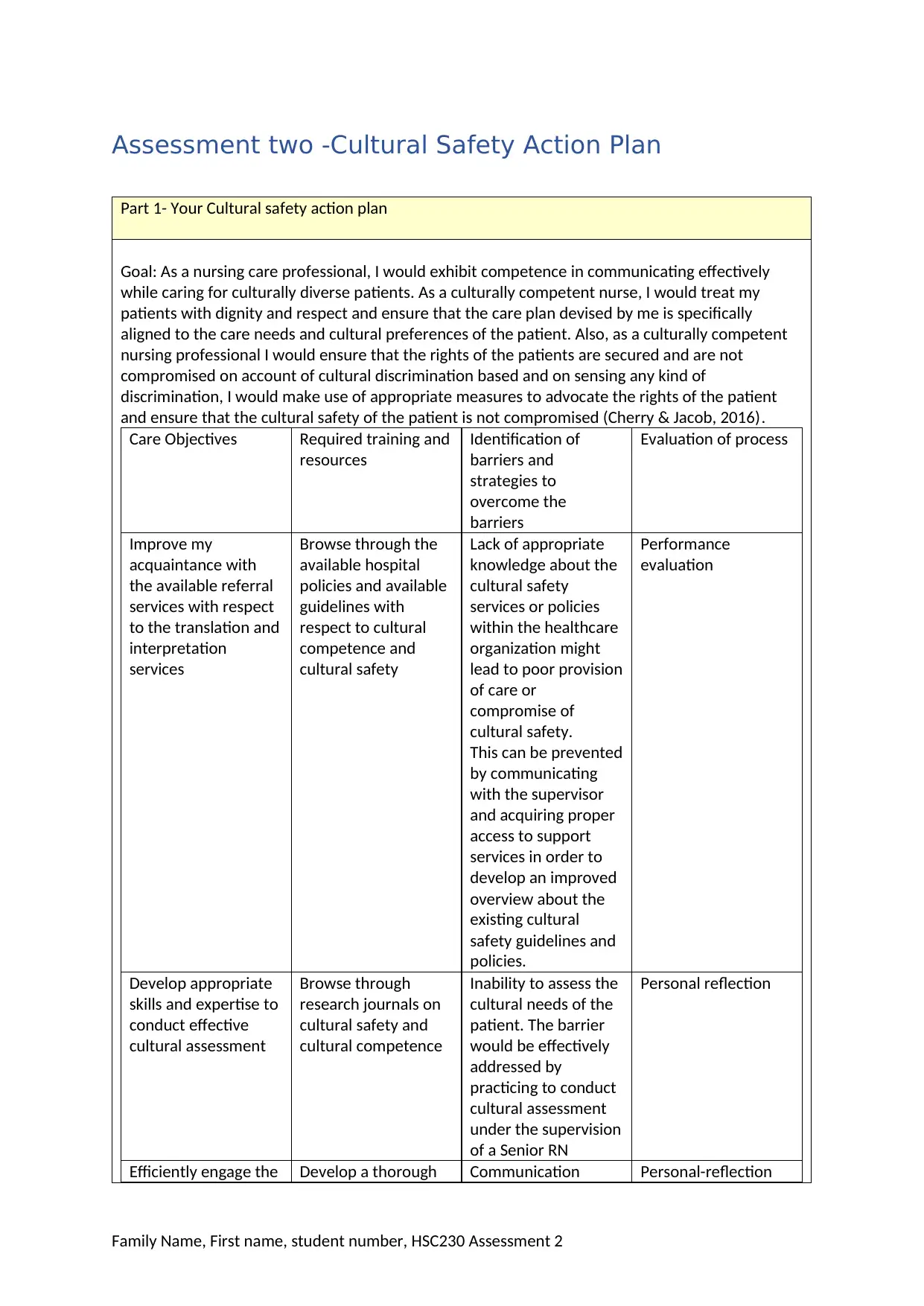
Assessment two -Cultural Safety Action Plan
Part 1- Your Cultural safety action plan
Goal: As a nursing care professional, I would exhibit competence in communicating effectively
while caring for culturally diverse patients. As a culturally competent nurse, I would treat my
patients with dignity and respect and ensure that the care plan devised by me is specifically
aligned to the care needs and cultural preferences of the patient. Also, as a culturally competent
nursing professional I would ensure that the rights of the patients are secured and are not
compromised on account of cultural discrimination based and on sensing any kind of
discrimination, I would make use of appropriate measures to advocate the rights of the patient
and ensure that the cultural safety of the patient is not compromised (Cherry & Jacob, 2016).
Care Objectives Required training and
resources
Identification of
barriers and
strategies to
overcome the
barriers
Evaluation of process
Improve my
acquaintance with
the available referral
services with respect
to the translation and
interpretation
services
Browse through the
available hospital
policies and available
guidelines with
respect to cultural
competence and
cultural safety
Lack of appropriate
knowledge about the
cultural safety
services or policies
within the healthcare
organization might
lead to poor provision
of care or
compromise of
cultural safety.
This can be prevented
by communicating
with the supervisor
and acquiring proper
access to support
services in order to
develop an improved
overview about the
existing cultural
safety guidelines and
policies.
Performance
evaluation
Develop appropriate
skills and expertise to
conduct effective
cultural assessment
Browse through
research journals on
cultural safety and
cultural competence
Inability to assess the
cultural needs of the
patient. The barrier
would be effectively
addressed by
practicing to conduct
cultural assessment
under the supervision
of a Senior RN
Personal reflection
Efficiently engage the Develop a thorough Communication Personal-reflection
Family Name, First name, student number, HSC230 Assessment 2
Part 1- Your Cultural safety action plan
Goal: As a nursing care professional, I would exhibit competence in communicating effectively
while caring for culturally diverse patients. As a culturally competent nurse, I would treat my
patients with dignity and respect and ensure that the care plan devised by me is specifically
aligned to the care needs and cultural preferences of the patient. Also, as a culturally competent
nursing professional I would ensure that the rights of the patients are secured and are not
compromised on account of cultural discrimination based and on sensing any kind of
discrimination, I would make use of appropriate measures to advocate the rights of the patient
and ensure that the cultural safety of the patient is not compromised (Cherry & Jacob, 2016).
Care Objectives Required training and
resources
Identification of
barriers and
strategies to
overcome the
barriers
Evaluation of process
Improve my
acquaintance with
the available referral
services with respect
to the translation and
interpretation
services
Browse through the
available hospital
policies and available
guidelines with
respect to cultural
competence and
cultural safety
Lack of appropriate
knowledge about the
cultural safety
services or policies
within the healthcare
organization might
lead to poor provision
of care or
compromise of
cultural safety.
This can be prevented
by communicating
with the supervisor
and acquiring proper
access to support
services in order to
develop an improved
overview about the
existing cultural
safety guidelines and
policies.
Performance
evaluation
Develop appropriate
skills and expertise to
conduct effective
cultural assessment
Browse through
research journals on
cultural safety and
cultural competence
Inability to assess the
cultural needs of the
patient. The barrier
would be effectively
addressed by
practicing to conduct
cultural assessment
under the supervision
of a Senior RN
Personal reflection
Efficiently engage the Develop a thorough Communication Personal-reflection
Family Name, First name, student number, HSC230 Assessment 2
Paraphrase This Document
Need a fresh take? Get an instant paraphrase of this document with our AI Paraphraser
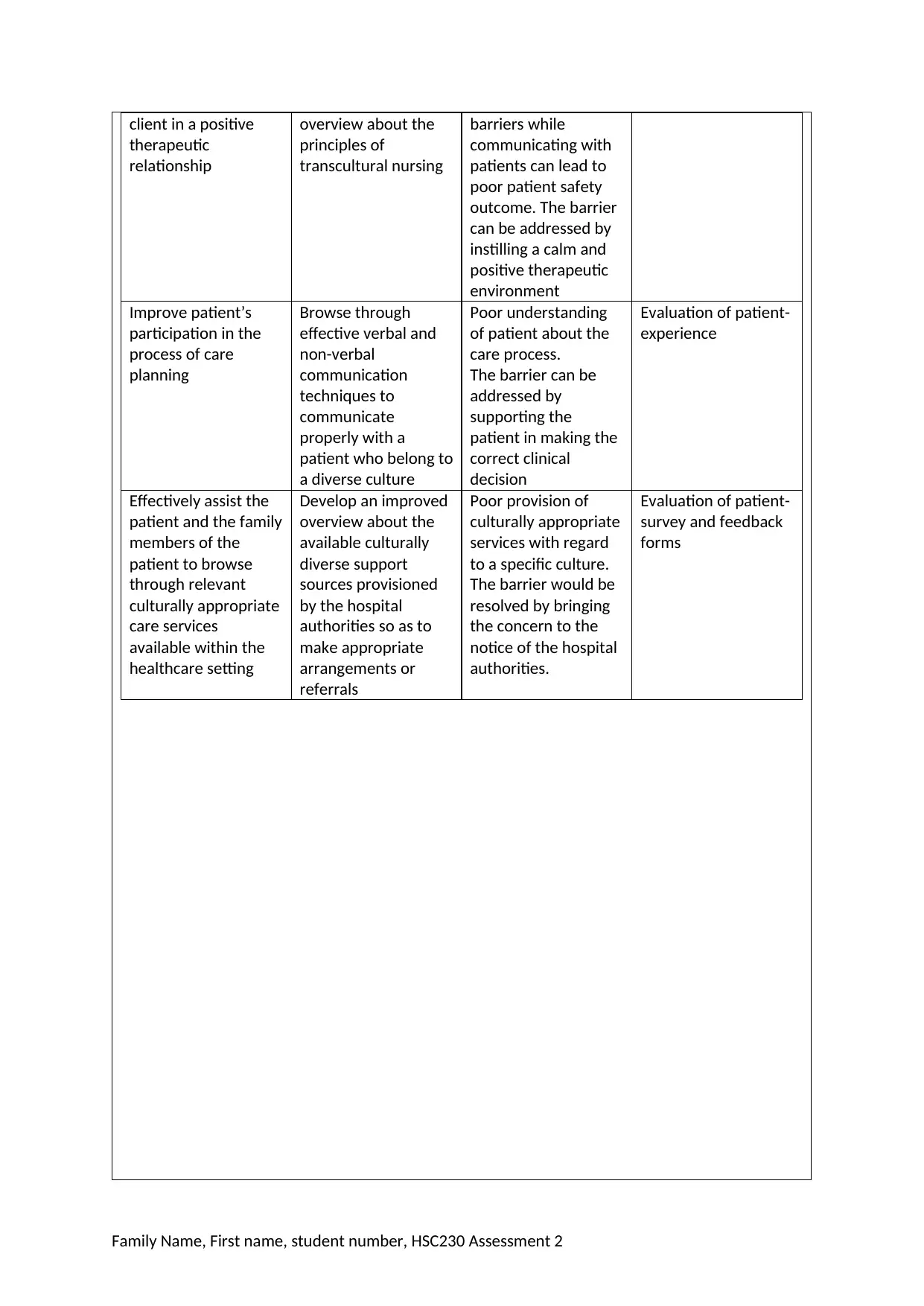
client in a positive
therapeutic
relationship
overview about the
principles of
transcultural nursing
barriers while
communicating with
patients can lead to
poor patient safety
outcome. The barrier
can be addressed by
instilling a calm and
positive therapeutic
environment
Improve patient’s
participation in the
process of care
planning
Browse through
effective verbal and
non-verbal
communication
techniques to
communicate
properly with a
patient who belong to
a diverse culture
Poor understanding
of patient about the
care process.
The barrier can be
addressed by
supporting the
patient in making the
correct clinical
decision
Evaluation of patient-
experience
Effectively assist the
patient and the family
members of the
patient to browse
through relevant
culturally appropriate
care services
available within the
healthcare setting
Develop an improved
overview about the
available culturally
diverse support
sources provisioned
by the hospital
authorities so as to
make appropriate
arrangements or
referrals
Poor provision of
culturally appropriate
services with regard
to a specific culture.
The barrier would be
resolved by bringing
the concern to the
notice of the hospital
authorities.
Evaluation of patient-
survey and feedback
forms
Family Name, First name, student number, HSC230 Assessment 2
therapeutic
relationship
overview about the
principles of
transcultural nursing
barriers while
communicating with
patients can lead to
poor patient safety
outcome. The barrier
can be addressed by
instilling a calm and
positive therapeutic
environment
Improve patient’s
participation in the
process of care
planning
Browse through
effective verbal and
non-verbal
communication
techniques to
communicate
properly with a
patient who belong to
a diverse culture
Poor understanding
of patient about the
care process.
The barrier can be
addressed by
supporting the
patient in making the
correct clinical
decision
Evaluation of patient-
experience
Effectively assist the
patient and the family
members of the
patient to browse
through relevant
culturally appropriate
care services
available within the
healthcare setting
Develop an improved
overview about the
available culturally
diverse support
sources provisioned
by the hospital
authorities so as to
make appropriate
arrangements or
referrals
Poor provision of
culturally appropriate
services with regard
to a specific culture.
The barrier would be
resolved by bringing
the concern to the
notice of the hospital
authorities.
Evaluation of patient-
survey and feedback
forms
Family Name, First name, student number, HSC230 Assessment 2
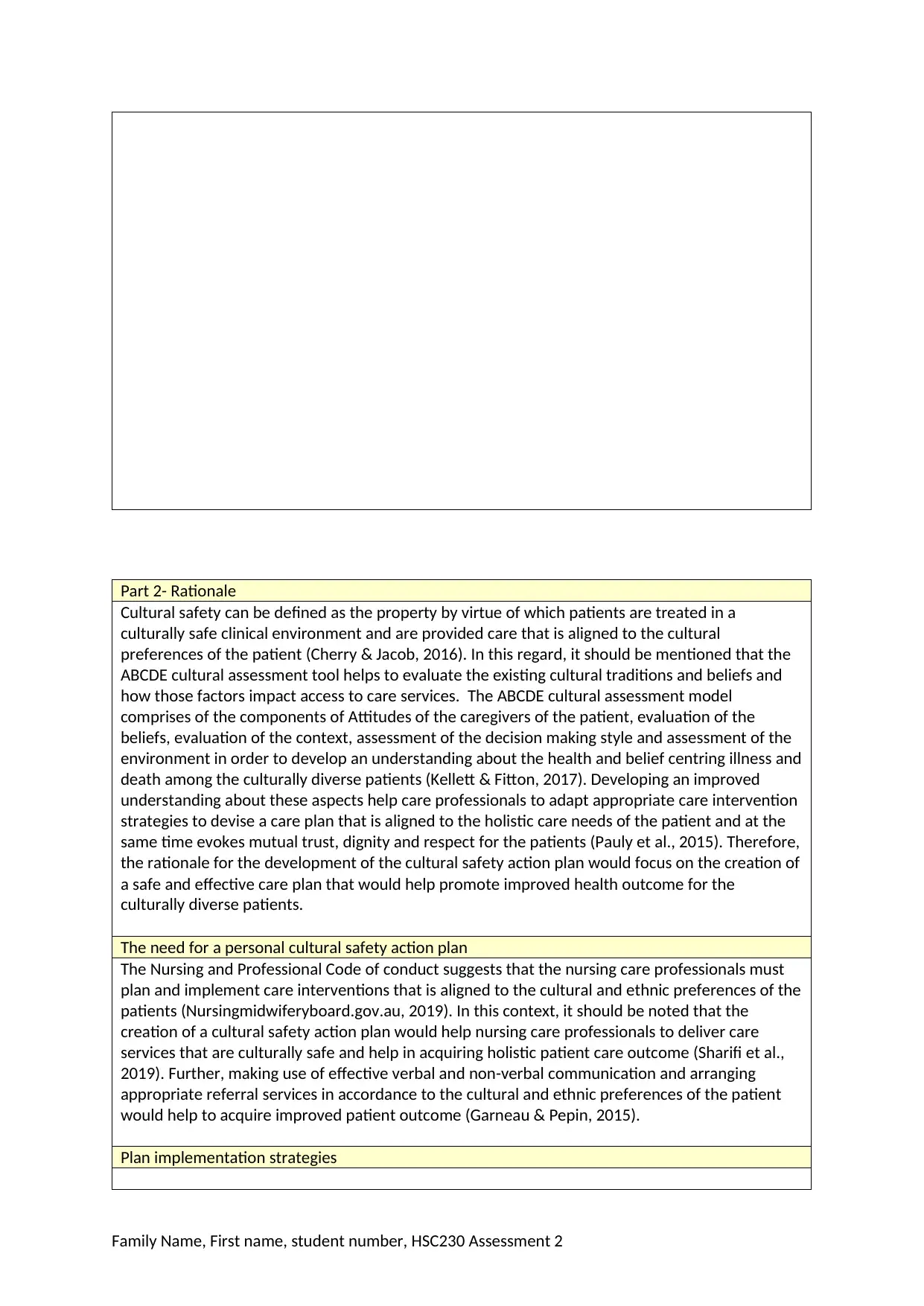
Part 2- Rationale
Cultural safety can be defined as the property by virtue of which patients are treated in a
culturally safe clinical environment and are provided care that is aligned to the cultural
preferences of the patient (Cherry & Jacob, 2016). In this regard, it should be mentioned that the
ABCDE cultural assessment tool helps to evaluate the existing cultural traditions and beliefs and
how those factors impact access to care services. The ABCDE cultural assessment model
comprises of the components of Attitudes of the caregivers of the patient, evaluation of the
beliefs, evaluation of the context, assessment of the decision making style and assessment of the
environment in order to develop an understanding about the health and belief centring illness and
death among the culturally diverse patients (Kellett & Fitton, 2017). Developing an improved
understanding about these aspects help care professionals to adapt appropriate care intervention
strategies to devise a care plan that is aligned to the holistic care needs of the patient and at the
same time evokes mutual trust, dignity and respect for the patients (Pauly et al., 2015). Therefore,
the rationale for the development of the cultural safety action plan would focus on the creation of
a safe and effective care plan that would help promote improved health outcome for the
culturally diverse patients.
The need for a personal cultural safety action plan
The Nursing and Professional Code of conduct suggests that the nursing care professionals must
plan and implement care interventions that is aligned to the cultural and ethnic preferences of the
patients (Nursingmidwiferyboard.gov.au, 2019). In this context, it should be noted that the
creation of a cultural safety action plan would help nursing care professionals to deliver care
services that are culturally safe and help in acquiring holistic patient care outcome (Sharifi et al.,
2019). Further, making use of effective verbal and non-verbal communication and arranging
appropriate referral services in accordance to the cultural and ethnic preferences of the patient
would help to acquire improved patient outcome (Garneau & Pepin, 2015).
Plan implementation strategies
Family Name, First name, student number, HSC230 Assessment 2
Cultural safety can be defined as the property by virtue of which patients are treated in a
culturally safe clinical environment and are provided care that is aligned to the cultural
preferences of the patient (Cherry & Jacob, 2016). In this regard, it should be mentioned that the
ABCDE cultural assessment tool helps to evaluate the existing cultural traditions and beliefs and
how those factors impact access to care services. The ABCDE cultural assessment model
comprises of the components of Attitudes of the caregivers of the patient, evaluation of the
beliefs, evaluation of the context, assessment of the decision making style and assessment of the
environment in order to develop an understanding about the health and belief centring illness and
death among the culturally diverse patients (Kellett & Fitton, 2017). Developing an improved
understanding about these aspects help care professionals to adapt appropriate care intervention
strategies to devise a care plan that is aligned to the holistic care needs of the patient and at the
same time evokes mutual trust, dignity and respect for the patients (Pauly et al., 2015). Therefore,
the rationale for the development of the cultural safety action plan would focus on the creation of
a safe and effective care plan that would help promote improved health outcome for the
culturally diverse patients.
The need for a personal cultural safety action plan
The Nursing and Professional Code of conduct suggests that the nursing care professionals must
plan and implement care interventions that is aligned to the cultural and ethnic preferences of the
patients (Nursingmidwiferyboard.gov.au, 2019). In this context, it should be noted that the
creation of a cultural safety action plan would help nursing care professionals to deliver care
services that are culturally safe and help in acquiring holistic patient care outcome (Sharifi et al.,
2019). Further, making use of effective verbal and non-verbal communication and arranging
appropriate referral services in accordance to the cultural and ethnic preferences of the patient
would help to acquire improved patient outcome (Garneau & Pepin, 2015).
Plan implementation strategies
Family Name, First name, student number, HSC230 Assessment 2
⊘ This is a preview!⊘
Do you want full access?
Subscribe today to unlock all pages.

Trusted by 1+ million students worldwide
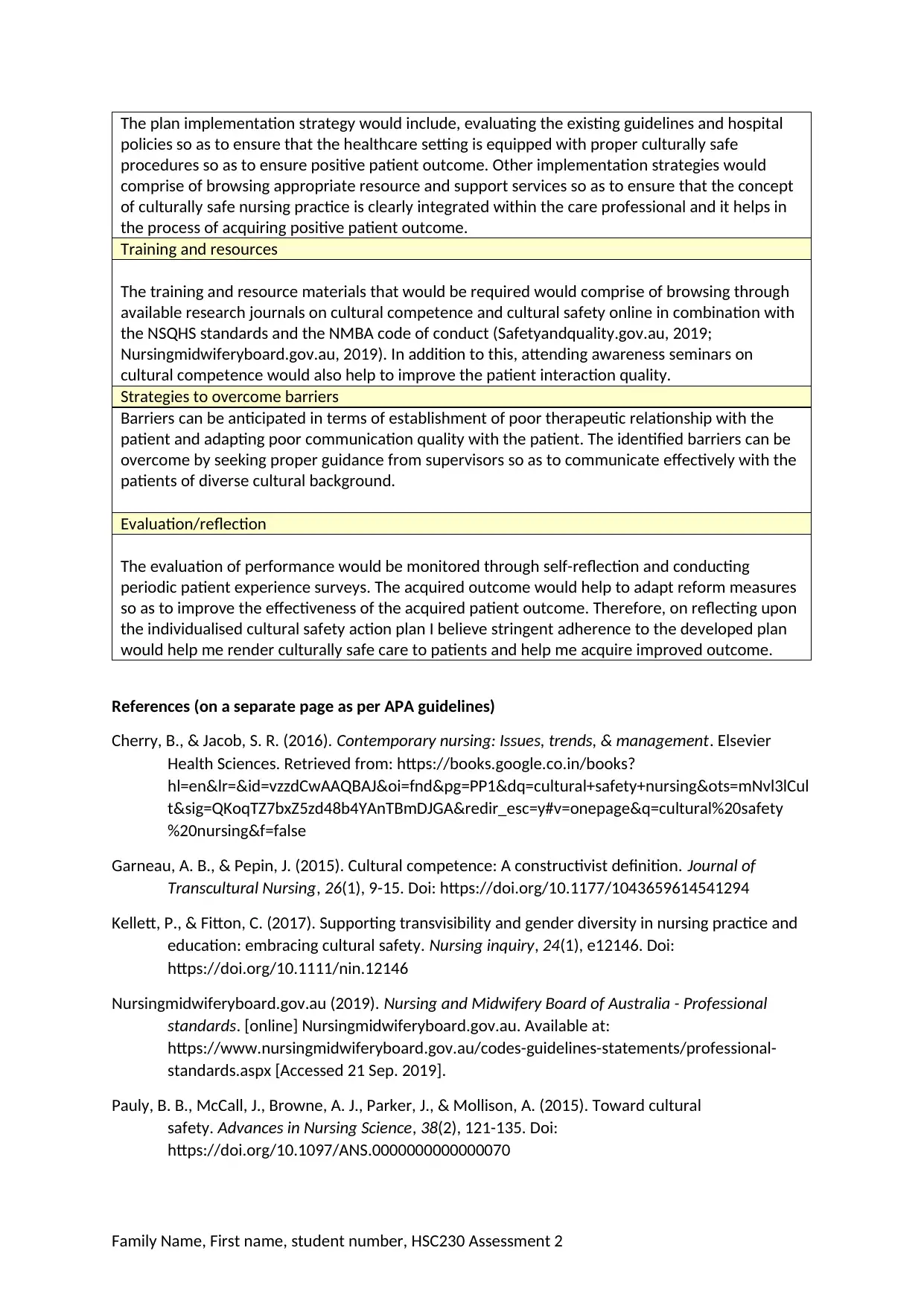
The plan implementation strategy would include, evaluating the existing guidelines and hospital
policies so as to ensure that the healthcare setting is equipped with proper culturally safe
procedures so as to ensure positive patient outcome. Other implementation strategies would
comprise of browsing appropriate resource and support services so as to ensure that the concept
of culturally safe nursing practice is clearly integrated within the care professional and it helps in
the process of acquiring positive patient outcome.
Training and resources
The training and resource materials that would be required would comprise of browsing through
available research journals on cultural competence and cultural safety online in combination with
the NSQHS standards and the NMBA code of conduct (Safetyandquality.gov.au, 2019;
Nursingmidwiferyboard.gov.au, 2019). In addition to this, attending awareness seminars on
cultural competence would also help to improve the patient interaction quality.
Strategies to overcome barriers
Barriers can be anticipated in terms of establishment of poor therapeutic relationship with the
patient and adapting poor communication quality with the patient. The identified barriers can be
overcome by seeking proper guidance from supervisors so as to communicate effectively with the
patients of diverse cultural background.
Evaluation/reflection
The evaluation of performance would be monitored through self-reflection and conducting
periodic patient experience surveys. The acquired outcome would help to adapt reform measures
so as to improve the effectiveness of the acquired patient outcome. Therefore, on reflecting upon
the individualised cultural safety action plan I believe stringent adherence to the developed plan
would help me render culturally safe care to patients and help me acquire improved outcome.
References (on a separate page as per APA guidelines)
Cherry, B., & Jacob, S. R. (2016). Contemporary nursing: Issues, trends, & management. Elsevier
Health Sciences. Retrieved from: https://books.google.co.in/books?
hl=en&lr=&id=vzzdCwAAQBAJ&oi=fnd&pg=PP1&dq=cultural+safety+nursing&ots=mNvl3lCul
t&sig=QKoqTZ7bxZ5zd48b4YAnTBmDJGA&redir_esc=y#v=onepage&q=cultural%20safety
%20nursing&f=false
Garneau, A. B., & Pepin, J. (2015). Cultural competence: A constructivist definition. Journal of
Transcultural Nursing, 26(1), 9-15. Doi: https://doi.org/10.1177/1043659614541294
Kellett, P., & Fitton, C. (2017). Supporting transvisibility and gender diversity in nursing practice and
education: embracing cultural safety. Nursing inquiry, 24(1), e12146. Doi:
https://doi.org/10.1111/nin.12146
Nursingmidwiferyboard.gov.au (2019). Nursing and Midwifery Board of Australia - Professional
standards. [online] Nursingmidwiferyboard.gov.au. Available at:
https://www.nursingmidwiferyboard.gov.au/codes-guidelines-statements/professional-
standards.aspx [Accessed 21 Sep. 2019].
Pauly, B. B., McCall, J., Browne, A. J., Parker, J., & Mollison, A. (2015). Toward cultural
safety. Advances in Nursing Science, 38(2), 121-135. Doi:
https://doi.org/10.1097/ANS.0000000000000070
Family Name, First name, student number, HSC230 Assessment 2
policies so as to ensure that the healthcare setting is equipped with proper culturally safe
procedures so as to ensure positive patient outcome. Other implementation strategies would
comprise of browsing appropriate resource and support services so as to ensure that the concept
of culturally safe nursing practice is clearly integrated within the care professional and it helps in
the process of acquiring positive patient outcome.
Training and resources
The training and resource materials that would be required would comprise of browsing through
available research journals on cultural competence and cultural safety online in combination with
the NSQHS standards and the NMBA code of conduct (Safetyandquality.gov.au, 2019;
Nursingmidwiferyboard.gov.au, 2019). In addition to this, attending awareness seminars on
cultural competence would also help to improve the patient interaction quality.
Strategies to overcome barriers
Barriers can be anticipated in terms of establishment of poor therapeutic relationship with the
patient and adapting poor communication quality with the patient. The identified barriers can be
overcome by seeking proper guidance from supervisors so as to communicate effectively with the
patients of diverse cultural background.
Evaluation/reflection
The evaluation of performance would be monitored through self-reflection and conducting
periodic patient experience surveys. The acquired outcome would help to adapt reform measures
so as to improve the effectiveness of the acquired patient outcome. Therefore, on reflecting upon
the individualised cultural safety action plan I believe stringent adherence to the developed plan
would help me render culturally safe care to patients and help me acquire improved outcome.
References (on a separate page as per APA guidelines)
Cherry, B., & Jacob, S. R. (2016). Contemporary nursing: Issues, trends, & management. Elsevier
Health Sciences. Retrieved from: https://books.google.co.in/books?
hl=en&lr=&id=vzzdCwAAQBAJ&oi=fnd&pg=PP1&dq=cultural+safety+nursing&ots=mNvl3lCul
t&sig=QKoqTZ7bxZ5zd48b4YAnTBmDJGA&redir_esc=y#v=onepage&q=cultural%20safety
%20nursing&f=false
Garneau, A. B., & Pepin, J. (2015). Cultural competence: A constructivist definition. Journal of
Transcultural Nursing, 26(1), 9-15. Doi: https://doi.org/10.1177/1043659614541294
Kellett, P., & Fitton, C. (2017). Supporting transvisibility and gender diversity in nursing practice and
education: embracing cultural safety. Nursing inquiry, 24(1), e12146. Doi:
https://doi.org/10.1111/nin.12146
Nursingmidwiferyboard.gov.au (2019). Nursing and Midwifery Board of Australia - Professional
standards. [online] Nursingmidwiferyboard.gov.au. Available at:
https://www.nursingmidwiferyboard.gov.au/codes-guidelines-statements/professional-
standards.aspx [Accessed 21 Sep. 2019].
Pauly, B. B., McCall, J., Browne, A. J., Parker, J., & Mollison, A. (2015). Toward cultural
safety. Advances in Nursing Science, 38(2), 121-135. Doi:
https://doi.org/10.1097/ANS.0000000000000070
Family Name, First name, student number, HSC230 Assessment 2
Paraphrase This Document
Need a fresh take? Get an instant paraphrase of this document with our AI Paraphraser
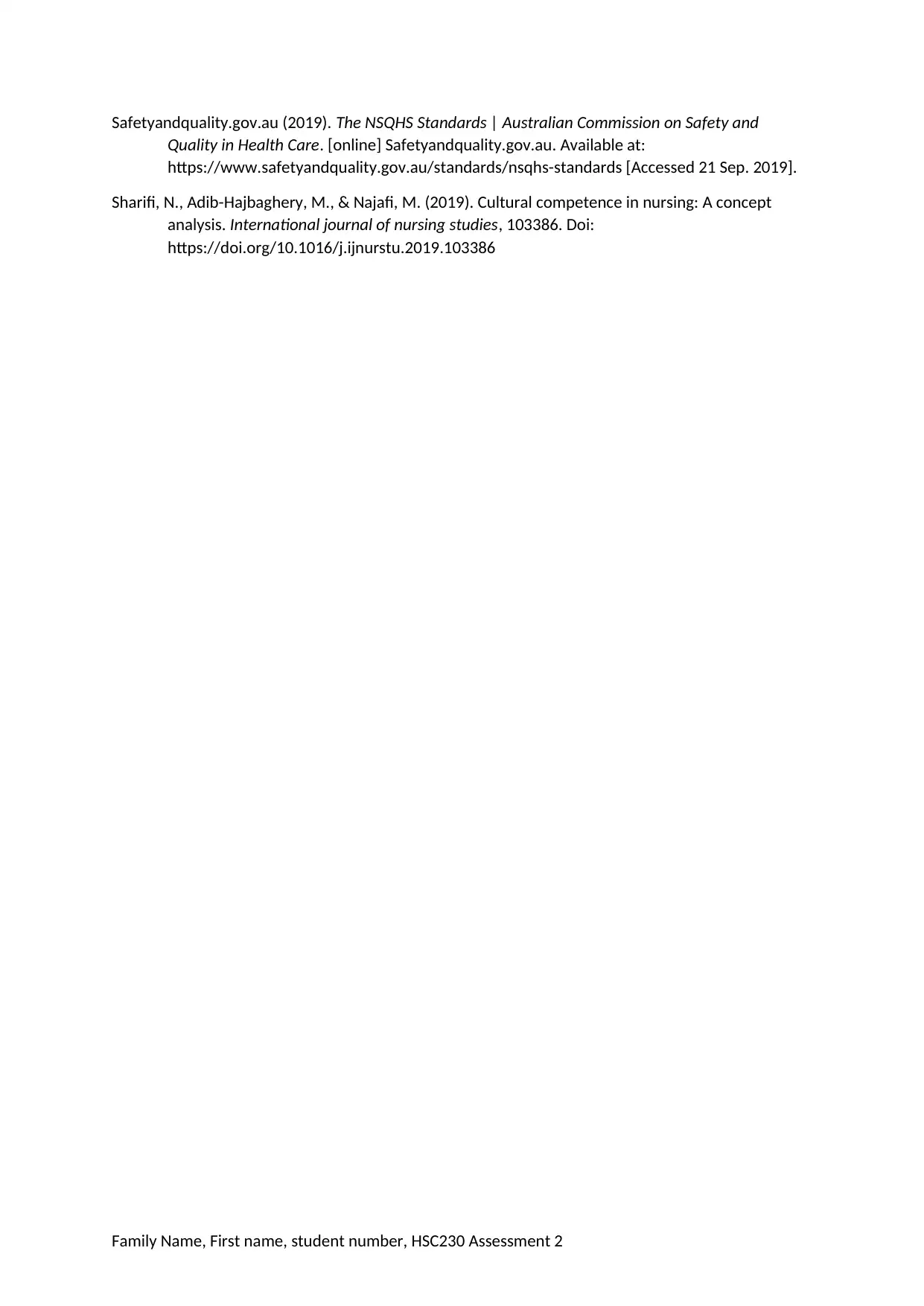
Safetyandquality.gov.au (2019). The NSQHS Standards | Australian Commission on Safety and
Quality in Health Care. [online] Safetyandquality.gov.au. Available at:
https://www.safetyandquality.gov.au/standards/nsqhs-standards [Accessed 21 Sep. 2019].
Sharifi, N., Adib-Hajbaghery, M., & Najafi, M. (2019). Cultural competence in nursing: A concept
analysis. International journal of nursing studies, 103386. Doi:
https://doi.org/10.1016/j.ijnurstu.2019.103386
Family Name, First name, student number, HSC230 Assessment 2
Quality in Health Care. [online] Safetyandquality.gov.au. Available at:
https://www.safetyandquality.gov.au/standards/nsqhs-standards [Accessed 21 Sep. 2019].
Sharifi, N., Adib-Hajbaghery, M., & Najafi, M. (2019). Cultural competence in nursing: A concept
analysis. International journal of nursing studies, 103386. Doi:
https://doi.org/10.1016/j.ijnurstu.2019.103386
Family Name, First name, student number, HSC230 Assessment 2
1 out of 5
Related Documents
Your All-in-One AI-Powered Toolkit for Academic Success.
+13062052269
info@desklib.com
Available 24*7 on WhatsApp / Email
![[object Object]](/_next/static/media/star-bottom.7253800d.svg)
Unlock your academic potential
Copyright © 2020–2025 A2Z Services. All Rights Reserved. Developed and managed by ZUCOL.




